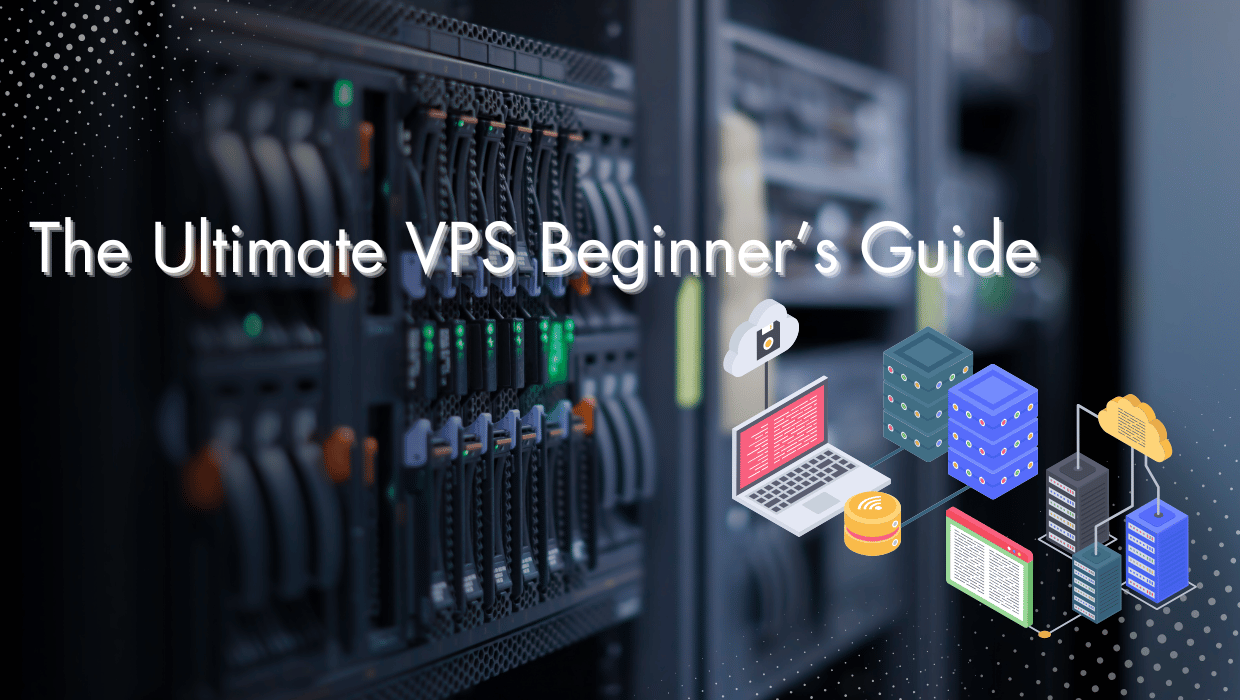Are you a writer planning to start your own blog but struggling to choose the right blogging platform?
WordPress, Medium, Substack, Squarespace and many others are popping up almost everyday. With the number of options available – it’s definitely overwhelming.
In this article, we’ll help you choose the best blogging platform for you by taking a close look at all of the top options available…

WordPress vs. Medium vs. Substack vs. Squarespace
In short, if owning your content is important to you, WordPress is the best option because it gives you full control over everything. Medium on the other hand is great for reaching an existing audience. Substack is the way to go if you want to monetize your content via subscription. Squarespace is the easiest option to set up, especially if you're just starting an online business and aren’t very tech-savvy.
1. WordPress for Writers
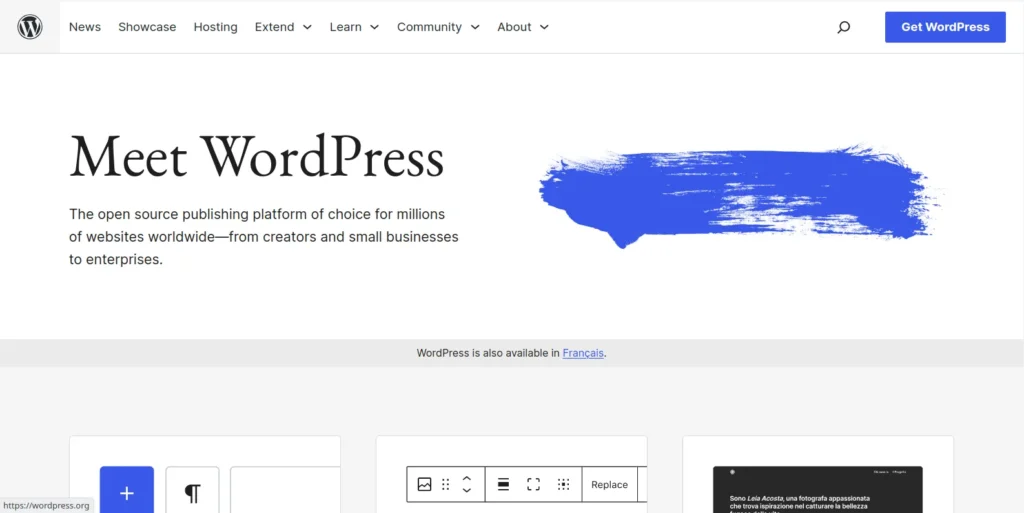
In this post, we’re referring to the free open-source WordPress.org blogging platform, not the WordPress.com hosting service.
WordPress.org is the free, Open Source web publishing software project, owned by no one individual or company. WordPress.com is a hosted blogging service run by a company called Automattic. Source.
What makes WordPress.org the world’s most popular blogging platform is the fact that it is open-source and theoretically also completely free to use – though pricing is something we’ll cover in detail later.
We wouldn’t be using WordPress as our content management system of choice for this blog (yes, the SSD Nodes blog you’re reading right now) if we didn’t think it was the best out there…
WordPress originally started its journey as a simple blogging system back in 2003, but it has since evolved to become an incredibly powerful platform that can be used to build almost anything, not just writing blogs!
From simple hairdresser booking websites all the way to real estate agency listing websites & social networks, WordPress has got your back…
WordPress: How Much Does It Really Cost?
It’s important to note that while WordPress as a content management system is completely free to download and use, there are other costs associated with running a blog powered by WordPress. One such cost is the yearly domain registration fee as well as a reliable web host…
On top of this, when building your website you may find that the functionality or appearance you’re aiming for is only achievable with the help of premium (paid) themes and plugins.
Domain Name Registration
Obviously, your website requires a domain name which is something that you’ll need to register separately when building a blog with WordPress. On average domains can cost around $11.99 per year and some can be more expensive (especially if you’re buying one that is already owned by someone else).
Hosting Costs
Obviously, when it comes to hosting, we’re biased but SSD Nodes offers powerful VPS hosting at a fraction of the cost of other hosting providers…
This and your domain name registration fees really can’t be avoided.
The Overall Experience
Overall, WordPress, for writers, and business owners, is extremely easy to work with. That being said, it is slightly more complicated to work with than Squarespace, Medium, and Substack but the benefits of that are that it’s also far more advanced and capable in terms of functionality, performance, and appearance.
Themes & Designs
There are over 13,000 free themes available just in the WordPress official theme repository. There are a number of other paid themes (usually more reliable than the free themes) that you can buy that also come with support from the developers.
Functionality & Integrations
In general, as of right now WordPress is without a doubt the most powerful blogging platform and content management system.
This is especially true if you want to keep your options open to be able to sell any form of physical or digital products at some point.
You want to turn your blog into an e-commerce shop? Easy. You can use Woocomerce.
Or maybe you want to have a newsletter? You can use MailPoet or Newsletter, both of which integrate seamlessly with WordPress.
You want to turn your blog into a membership site? Use MemberPress.
You’re contemplating selling an online course? LearnDash has you covered.
WordPress really offers endless possibilities.
So if growth, customizability, and planning for the future are what you’re looking for then WordPress is the obvious choice…
Data Ownership
WordPress is open-source. You are the sole owner of what you create. You’re free to switch hosts, migrate, change themes, and redesign or remove everything whenever you want…
The rest of the writing platforms we’ll be covering in this article – Medium, Squarespace, and Substack are all closed platforms that control your content and make it difficult to migrate the content. Thankfully, this is not the case with WordPress and one of the reasons we love it and rely on it for our own website.
You aren’t bound to set terms of conditions or terms of service that could change and put your entire business at risk without warning.
WordPress Cons
While WordPress is a powerful platform, it's not without its drawbacks.
The main challenge with WordPress is that it requires a bit of technical knowledge, not too much, just a little. If you're not familiar with web hosting and installing open-source software, getting up and running with WordPress may initially require you to invest a few hours to learn how things work. We make this easier with our WordPress 1-Click App.
Once you understand how WordPress works, you’ll be glad you learned many valuable skills.
2. Medium for Writers
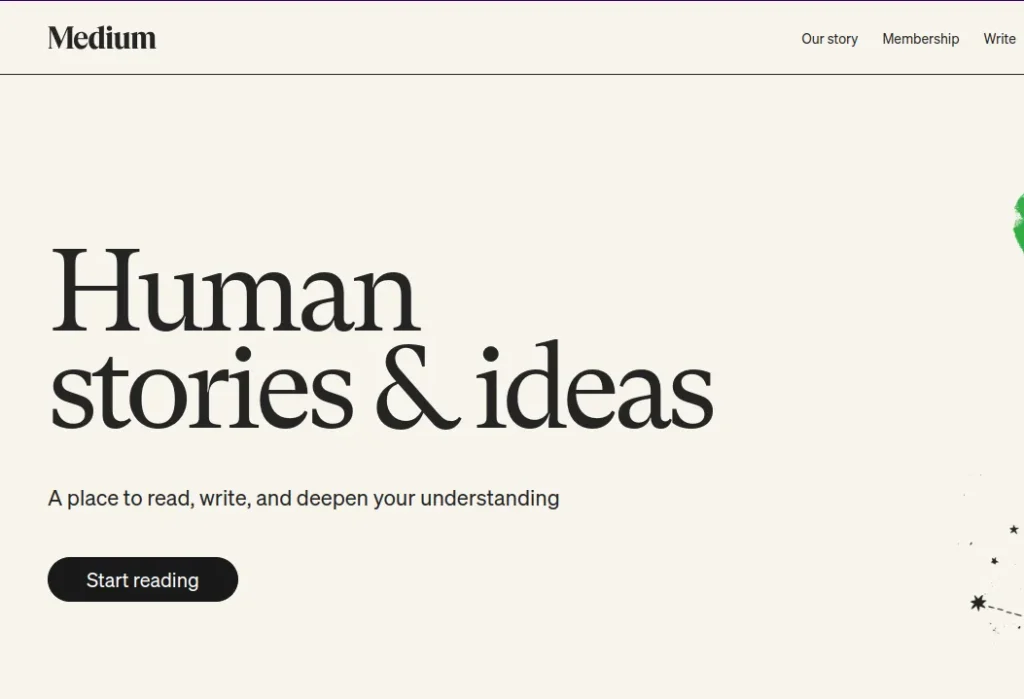
For writers, Medium is definitely the easy choice to start with. Building an audience is often easier and you don’t have to spend much time designing anything or setting things up – but do you really want to build your audience on a platform you don’t own or have any control over?
I completely understand the allure to use a platform like Medium and I read articles on there from time to time. After all, it is a great place for your work but it has flaws that stop me from using it.
Nonetheless, Medium as a blogging platform can’t be overlooked since it’s definitely among the best available – so, let’s take a closer look at how it stacks up…
Medium Pricing
Publishing your content on Medium is completely free. But you must pay $5/month if you want to set up a custom domain and read member-only stories.
Writers can earn money by enrolling in the Medium Partner Program, which is free and open to the public. If you want to start writing solely to generate revenue off of writing (i.e. with no other real business model), Medium could be a good place to start and tap into an existing network to grow an audience of your own.
There is a cost to this, however, which is that Medium puts your content behind a paywall limiting its access to the public.
You may be familiar with this somewhat annoying screen:
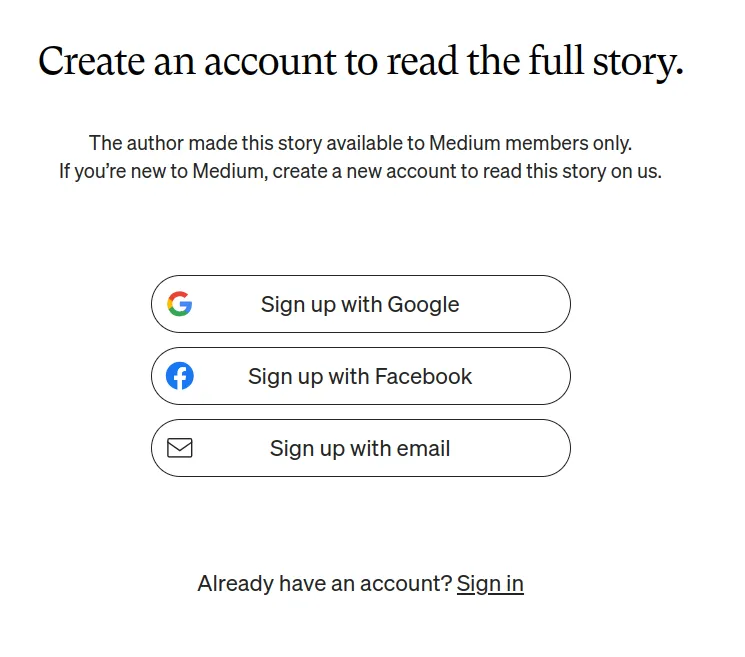
The nature of the platform is that readers who sign up and do not pay $5/month are only able to read up to three member-only articles per month. To continue reading past this limit you need to become a paying member.
Note: There is an option that allows you to make your articles open to the public if you wish.
The payouts are mostly determined by the the total time that Medium members spend reading a writer's article – the more time readers spend reading your article, the more you get. Medium also uses engagement metrics such as claps, comments, and boosts to determine the earnings of each article. The earnings are mainly from the members monthly ($5) subscription.
The Overall Experience of Medium
The platform was originally developed by Evan Williams, the co-founder of both Twitter and Blogger.com, in August of 2012. Their main goal was to create a place where people could express themselves.
The platform focuses on the blogging process itself, making it ideal for beginners or bloggers who just want to express themselves and don’t expect much out of their blogs.
So, as you’d expect, the process of getting started is really simple. All you need to do is sign up for a free account and start creating and sharing content.
Themes & Designs on Medium
Although the writing experience on Medium is great, when it comes to design & customization, there’s basically nothing that can be done. Medium and Substack are the two most limiting platforms.
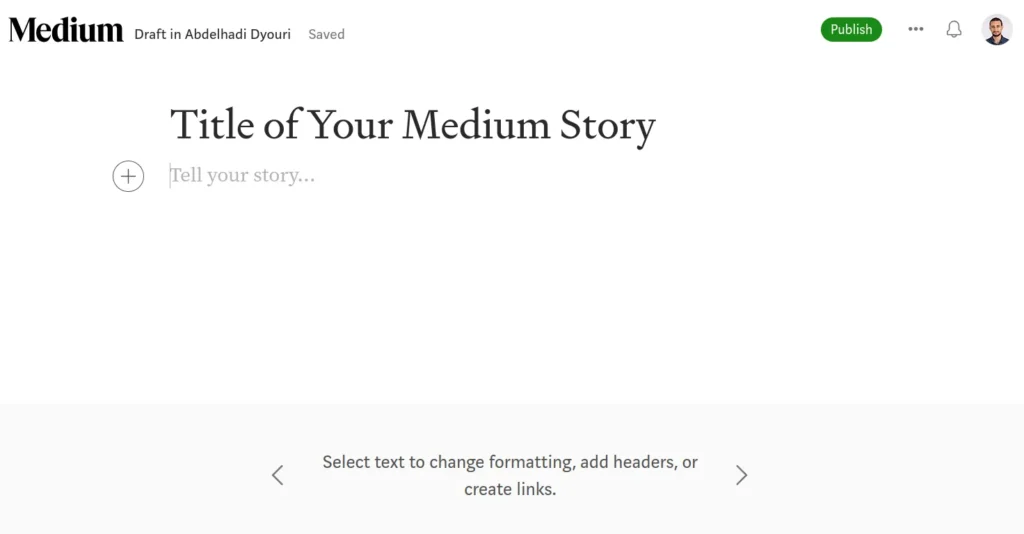
Unfortunately, even if you were to start a publication instead of just posting articles on your user profile, the customization options are really limited - all you can really do is add a logo, choose whether articles should appear as a grid or list and change some colors…
Medium: Functionality & Integrations
What you can do with your Medium profile or publication is virtually nothing when compared to a fully-fledged platform like WordPress.
So as long as you’re not planning to use your site to generate leads for your business, or anything other than sharing content & growing an audience – Medium is definitely still an option worth considering.
Data Ownership
One major disadvantage of Medium and in my opinion “the final straw” is that you don’t own your blog and the content you share on Medium. If Medium decided to stop running their platform, you would lose all of your data and all of the effort you’ve dedicated to growing a following, so this is definitely something to bear in mind.
3. Substack for Writers

Substack has quickly become the go-to for writers and journalists who want to monetize their work with subscription-based newsletters. Exactly like Medium, it is actually fairly simple to use and doesn’t require you to get your hands dirty with things like hosting and design or complicated setups. You just write and Substack does the rest: email distribution, payments, analytics, and so on..
Substack is a rather great platform if you’re looking for an easy way to start a newsletter, but you’ll need to build your audience outside the platform. Substack actually has a nice article detailing how you can get your first 100 subscribers.
In case you already have an existing mailing list, you can import it to Substack and they will take care of everything else, which is amazing.
Substack Pricing
Like Medium, Substack has the selling point of being completely free to start.
Once you start making money with paid subscriptions, Substack takes its cut, taking 10% of your earnings.
Overall Experience of Substack
If you’re looking for a platform that makes publishing blog posts and paid newsletters as easy as pie, Substack has got you very much covered. With it being designed for people who just want to write and get their content out there without fussing over the technical stuff. The good thing here is that you don’t have to worry about managing servers, setting up payment systems, or even maintaining a website. Substack takes care of all that for you.

Unlike Medium, your readers directly pay you when they subscribe to your newsletter. Of course, you can write a blog post on Substack just like any other blogging platform, but the core strength of Substack is that you get to send content directly to subscribers via email.
In general, Substack is great for anyone who wants to build a subscriber base, and get paid directly from their audience.
Substack Themes and Design
Similar to Medium, this where Substack is pretty bare-bones. You’ve got a couple of basic layouts, and that’s about it. There really isn't much of a room for customization beyond adding a logo or choosing a color. In case you’re fine with a minimalist look, this won’t bother you, but if you like getting creative with branding and design, you’ll likely find Substack a little restrictive. Although to be fair, they do offer more control over email layouts.
Substack Functionality & Integrations
Substack keeps things simple, which is great for people who just want to write and build a subscriber base. But the trade-off is that you lose out on the more advanced functionality you’d get with platforms like WordPress. There aren’t that many integrations, and customization is pretty much nonexistent.
Substack Data Ownership
Here’s where things are a little complicated. With Substack, you don’t fully own your content. Both your articles and the email list lives on Substack’s servers, not yours. Although there is a way you can export your list, but if you ever want to move off the platform, getting that data to work elsewhere might be a hassle. Additionally, you can’t take your substack followers with you off the platform. This can be a big deal if you’re looking to have full control over your subscriber base and want the freedom to take your data wherever you go.
Thankfully, platforms like WordPress don’t have this issue, since you own everything.
4. Squarespace

Squarespace has been on the market for quite some time now. It was founded in 2004 and as of present, they’ve managed to grow to a team of over 1,700 people.
You’ve likely heard of them on a podcast or YouTube channel because they spend a lot of money on advertising.
The platform works with pre-built website templates and drag-and-drop elements to create and modify webpages. This is great for people that don’t want to get their hands dirty or learn anything about building websites on their own, but there are a few setbacks..
Squarespace: Pricing
Squarespace takes pride in letting people know there are no hidden fees and you only pay for the amount on the plan you choose. It offers a 14-day free trial (no credit card required) and if you’re satisfied after taking it for a spin, there are four plans you can choose from.
Squarespace Personal
The first one is the Personal plan, which costs $25 monthly, with the option to save 36% if you pay annually. With this plan, the domain costs an additional $20 if you pay monthly, and is free if you pay annually.
Squarespace Business
Their second plan – the Business plan – costs $36 per month but if you decide to pay annually you can save 36%. The domain pricing is the same as on their personal plan. This plan provides access to basic eCommerce functionality, advanced analytics, and more…
Squarespace Basic & Advanced Commerce
The Basic Commerce ($40/month) and Advanced Commerce ($72/month) are the only other plans that Squarespace offers. plans that Squarespace offers. When paying annually, you can save up to 30%.
Their pricing platform is definitely more expensive than all of the other blogging platforms here.
Due to their pricing model, getting started with Squarespace as a writer is more expensive than any of the other alternatives we looked at in this post. And, in addition to this, there is also a hidden cost associated with the fact that it is a closed platform with limited functionality and migrating isn’t as easy as it should be.
Squarespace: The Overall Experience
As a complete package, Squarespace is great – especially for beginners because it’s really easy to use. It basically bundles a lot of the tools & services that you would need to manually set up otherwise.
The great thing about Squarespace is that it’s not just for writing and blogging, you can create websites for a variety of other purposes, including online stores, portfolios, and business websites.
While we can only speak for ourselves for this, we also know thousands of others would agree that the additional control and flexibility is worth the extra setup time required.
If you also think you’re the type of person that might require a bit of handholding to get their site ready – Squarespace offers excellent support that is available on chat.
Squarespace: Themes & Designs
Squarespace offers a set number of templates that are available from their library on all of the plans, but beyond that there is very little customization that can be done.
Learn more about the type of templates that are available here.
Squarespace: Functionality & Integrations
If your blog is your main focus, then Squarespace does its job pretty well. In terms of functionality, it offers a feature-rich commenting option, multi-author functionality, and you can even create podcasts on this platform.
On top of this, they do have integrations with 3rd party software which they refer to as Squarespace Extensions. Most of them are only really useful if you’re using Squarespace’s built-in eCommerce functionality such as Mailchimp for handling emails and SMS messages, custom merch by Printful, and ShipStation for shipping goods.
The feature set, integrations, and what's possible with Squarespace overall doesn't compare to fully-fledged content management systems like WordPress, where you can integrate everything from advanced email marketing tools and SMS APIs to complex inventory management systems and custom payment processors.
Squarespace: Data Ownership
Just like Substack and Medium, Squarespace isn’t self-hosted & it’s a closed-platform meaning that you aren’t truly in control of your data, audience and what you can do with your website.
Fortunately, if you want to move your data they do let you export your content, which makes it possible to move to WordPress.
So, what’s the best blogging platform?
This is the only real way to make the right decision.
If you only ever plan on publishing articles and nothing more – but want to make use of an existing audience then Medium is the way to go. But, if you aren’t a fan of Medium and are slightly concerned with the way they handle data ownership, WordPress is a great blogging platform that you truly control. If you plan on monetizing your writing via paid subscriptions, then Substack is the way to go.
If you want to build an online business such as an eCommerce store, and you’re not tech-savvy, then Squarespace would be the best choice for you.

